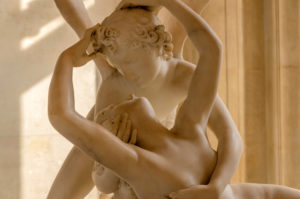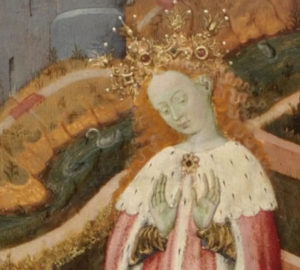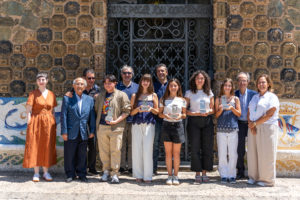February 17, 2023
By: Ferran Garcés

Cupid and Psyche. Two lovers about to give a kiss. Erotic and love concept.
We are in the week of Valentine’s Day. Bellesguard has a very appropriate symbol for the occasion. We refer to the stained glass window called “Star of Venus”. In ancient times, because of its luminosity, the planet identified with the Roman goddess of love and beauty, was described as a star. Due to this brilliance, which can be perceived both day and night, it was also known as “Morning Star”, and the “Evening Star”. A celestial phenomenon that, over time, has become a symbol with many meanings.
In the specific case of Bellesguard, as we have seen in previous entries, the stained glass window designed by Gaudí could be a reference both to
the Virgin Mary or
the Magi, but it has also been identified with Venus, the goddess of love. It would be a reminder of the most remarkable event in the history of the old Bellesguard castle: the marriage of King Martin I the Humane to Margarida de Prades on 17 September 1409. This marriage took place at a time of transition from the Middle Ages to Humanism, the cultural movement characterized by the revival of classical antiquity, including its mythology, and Venus was one of the most popular figures rescued by humanist poets and artists. Since then, the imaginary Venus has been a recurring theme in Western art.
In this context, we recall that King Martin I was known as “the Human” because of the importance of Humanism at his Court, and that Queen Margarida organized a literary court around him, herself becoming a source of inspiration for the leading poets of the time. On the occasion of her funeral, the well-known Castilian poet Marqués de Santillana even dedicated a funeral “plantó” to her, which begins with the vision of Venus weeping and asking all the lovers of the past to join him in a tribute to the venerable Queen Margarida. She has died “the best of the best”, the poet literally writes in the mouth of the ancient goddess (1).
Venid, venid, amadores,
de la mi flecha feridos,
e sientan vuestros sentidos tormentos,
cuytas, dolores; pues que la muerte llamar
ha querido e rebatar
la mejor de las mejores.
But… was this queen’s only relationship with Venus her marriage to Martin I? Of course not. The queen had another love, a secret love, a tragic love? As a royal widow, Margarida could continue to live in Bellesguard and enjoy other Crown property, as long as she remained a widow. Even so, she took a risk and secretly married Juan de Vilaragut y Álvares de Haro, a court nobleman, in 1415, and had a son a year later. The marriage took place in Valencia. Unfortunately, their relationship became public and the royal widow lost all her privileges, including the palace of Bellesguard. It seems that, for a time, they took refuge together in the Monastery of Valldonzella, where her first husband, Martin I, had died in 1410, and where, curiously, her second husband, the forbidden one, also died in 1422.
From Valldonzella, once again widowed, the queen moved to another convent much further away and exclusively for women, that of Bonrepòs, in the Montsant mountain range, in Tarragona. It should be remembered that Margarida was born in Prades, a village near the monastery. In the Middle Ages, many hermits settled in this mountain range, which is why it was known as “the holy mountain”. Despite being in an isolated area, an outbreak of plague carried off the beautiful queen in 1429. It was then when the Marques of Santillana dedicated his poem to Margarida de Prades, “the best of the best”. The memory of her beauty remained so pungent that one of the best poets of his time still considered her worthy of the tears of Venus…
Notes
(1) Fort y Cogul, Eufemià,
La leyenda sobre Margarida de Prades, Fundación Salvador Vives Casajuana, Barcelona, 1970, pp. 52-58
On the Internet: Pons, Marc: “Margarita de Prades, la última reina catalana en lo trueno de Barcelona”, Elnacional.cat, Barcelona, 30 July 2022.
(2) The full name of the poem is “Lo planto de la reina Margarida”. For its literary context, see: Pérez Priego, M.A.: “El Marqués de Santillana y la Corona de Aragón lo marco del Humanismo peninsular”, Revista de lenguas y literaturas catalana, gallega y vasca, No. 9, 2003, pp. 29-40.






